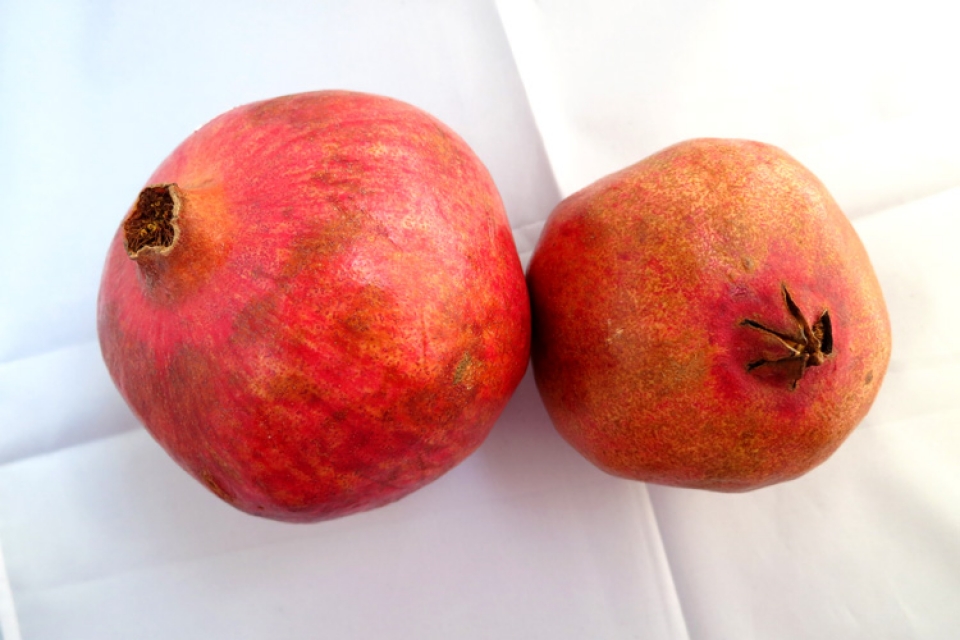How to Seed a Pomegranate
Pomegranates are a delicious treat this time of year, but I know I'm not alone when I say they are one intimidating fruit. How do you know when they are ripe? How do you cut it? How do you get all those delicious kernels out of the intricate pith inside? But once you figure it out and taste the sweetness of the seeds, all that work seems totally worth it and not as hard as initially thought.
After taking a quick survey of our staff, we realized there are different methods for seeding a pomegranate, and so we set out to figure out which technique works best. Keep reading for a "how to seed a pomegranate" guide to help you enjoy these winter fruits.
Step 1: Selecting a Ripe Pomegranate
How do you know when a pomegranate is ripe? It should feel slightly heavy (like it's full of juice), fairly hard, and kind of squared on the sides (rather than perfectly round). The color isn't necessarily a good way to gauge ripeness, and any blemishes on the skin shouldn't affect the taste or quality of the pomegranate seeds.
Pomegranates should feel slightly heavy, hard, and slightly squared on the sides
Step 2: Prepare Your Tools
No matter which method you choose, you will need a sharp knife to score the pomegranate in order to open it. If you opt for the water method (more on that below), you will also need a deep bowl filled part way with water. If you choose the whacking method, you'll need a deep bowl and a whacking instrument, such as a wooden spoon.
It also helps loosen the seeds to roll your pomegranate on the table while applying some pressure. You should feel some of the seeds release inside.
Step 3: Score the Pomegranate
Water method: score the pomegranate in quarters (cut through the skin, but not too deep - you don't want to hit the seeds!)
For the water method, score your pomegranate in quarters
Whacking method: score the pomegranate around the middle, making sure to not cut too deeply or into the seeds.
For the whacking method, score the pomegranate around the middle
Step 4: Choose Your Method and Extract the Seeds
Water method: holding the pomegranate under the water in your deep bowl, break apart the fruit along the quartered score cuts. Work the seeds out of each quarter with your fingers. The seeds should sink to the bottom of the bowl, while the pith should float on top of the water. When you've extracted all the seeds, scoop out the pith and drain the seeds. Enjoy!
Whacking method: pull apart the pomegranate along the scored cut into two halves (it may help to twist the two halves slightly in opposite directions). Take one half and hold it with the seeds facing down over your deep bowl. Using both hands, pull slightly at the edges of the pomegranate half to loosen up the seeds. Now, keep your pomegranate half facing down into the bowl and grab your wooden spoon. Start whacking the top of the pomegranate with the spoon. The pressure exerted from above should shake the seeds loose into the bowl. Keep whacking until most of the seeds have been extracted. It may help to squeeze the pomegranate lightly to encourage seeds to fall. Pick out any remaining seeds from the pomegranate and enjoy!
As you can tell from the videos above, the water method was by far the easier of the two methods we tried (and less messy!). However, if you're looking to work out some frustration, the whacking method may be right up your alley! Just keep in mind that pomegranate juice is quick to stain clothing, so seed with care. Another interesting fact we realized is that the pomegranate seeds were more vibrantly red when extracted via the whacking method as opposed to the water method, due to some of the juice leaching out into the water. If you are looking to make a statement or are interested in preserving the seed color, opt for the whacking method.
Pomegranate half
Our Facilities Manager also mentioned that he likes to cut open pomegranates like you would a pumpkin, survey the pith lines from above, and then cut down vertically along those pith lines to create pomegranate wedges that are then easily cleaned. Whatever method you choose to use, we promise the reward at the end is well worth it!
Wondering how to use pomegranate seeds (other than eating them out of hand)? Check out these recipes:
Pineapple and Pomegranate Granita
Butter Lettuce and Endive with Pomegranate Jewels
Shredded Salad with Pomegranate and Hazelnuts
Great Big Fruit Salad
